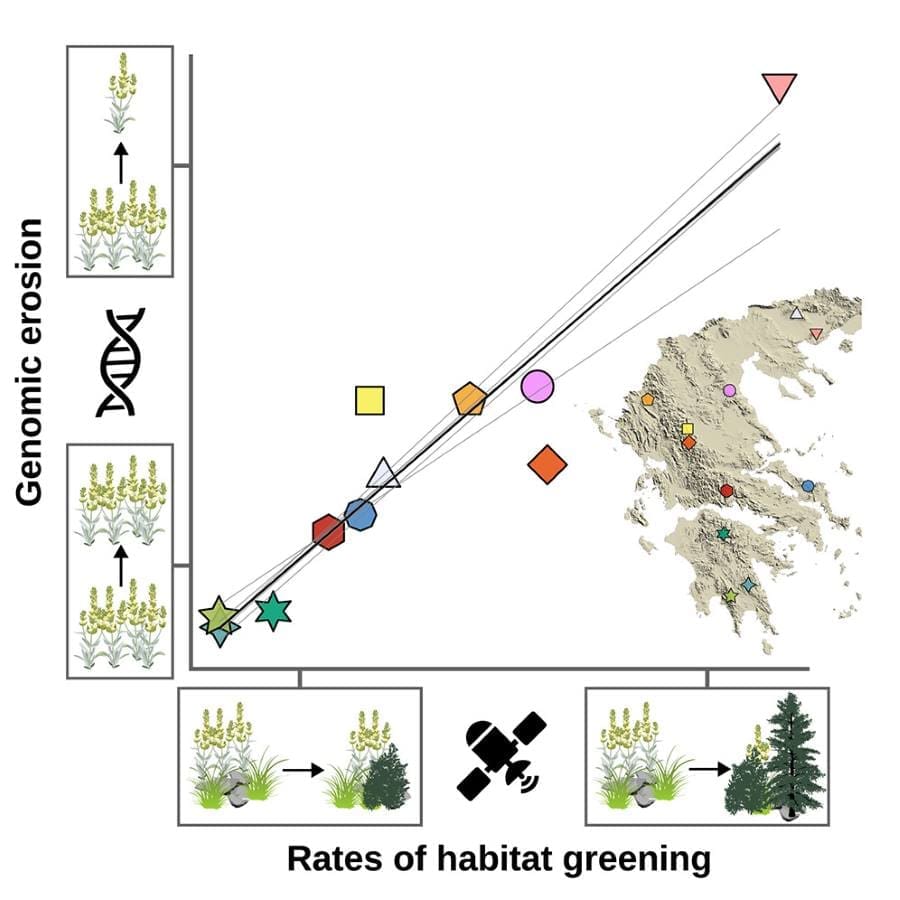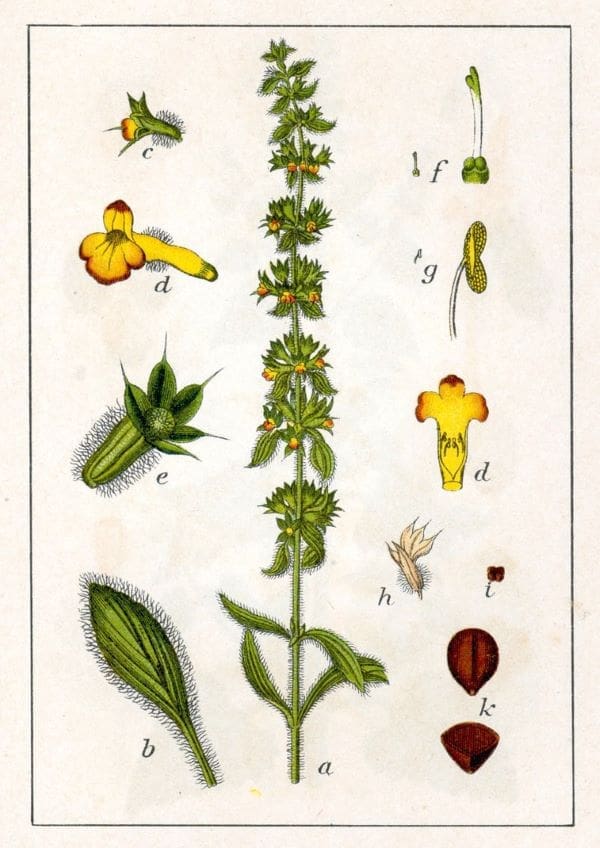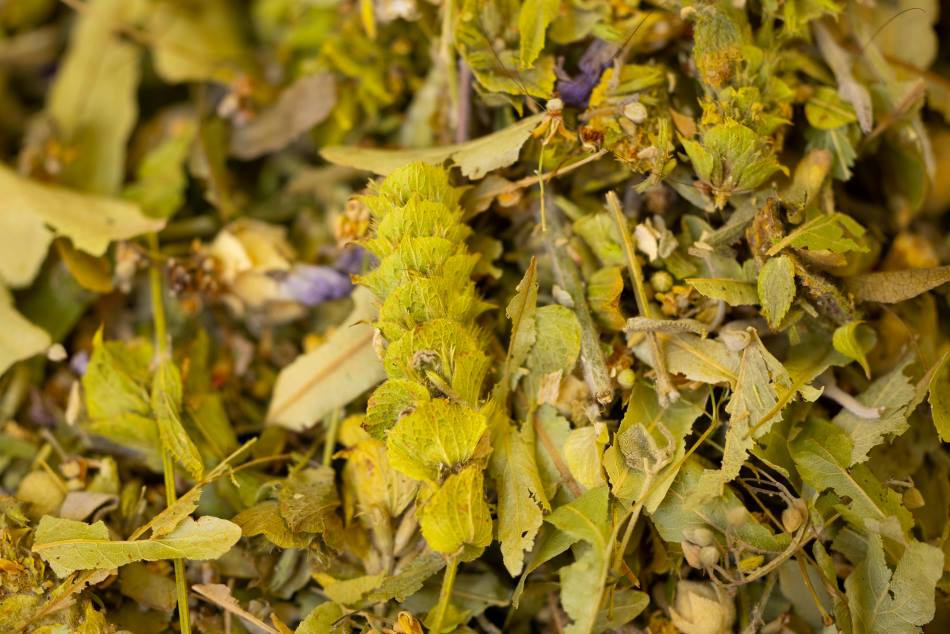Summary:
As Europe’s mountain landscapes become greener due to climate change and land-use shifts, the genetic diversity of some native plant species is quietly declining. A new study published in Current Biology shows that this genomic erosion is now visible from space. Researchers combined 40 years of satellite imagery with genomic data from herbarium specimens and modern field samples to investigate the fate of Sideritis – commonly known as Greek mountain tea – across eleven mountain ranges in Greece. This medicinal herb, long valued for its healing properties and symbolic of open grassland habitats, is now under pressure from encroaching shrubs and trees.
The study found that in eight of the eleven regions studied, genetic diversity in Sideritis populations has significantly declined, with some plants showing up to 20% of their genome affected by inbreeding. Crucially, these changes closely correlate with satellite-recorded increases in vegetation density, measured through the normalized difference vegetation index (NDVI).

Loss of genetic plant diversity is visible from space
Mountain regions are hotspots of biodiversity and represent some of the most species-rich habitats overall. However, these diverse ecosystems are being rapidly transformed by global change.
Over the past five decades, rising temperatures and changes in land use at high altitudes have encouraged the growth and spread of highly competitive plants such as shrubs and trees – a process known as “mountain greening.” The specialized and often low-growing species of open grassland habitats are being pushed back as a result.
Sideritis, a characteristic and important plant of the montane grassland flora in the Mediterranean region, is also affected by this development. The herb, also known as Greek mountain tea, comprises several closely related species and is used by the local population and the pharmaceutical industry due to its healing properties for coughs, colds, and gastrointestinal complaints.
At the same time, the popular medicinal plant is an indicator of the health of open mountain habitats.

As part of the recently published study, the research team investigated the effects of increasing greening on the genetic diversity of Sideritis, using an innovative methodological approach:
“We examined populations in eleven Greek mountain ranges and combined satellite data from several decades with genetic analyses of herbarium specimens from the 1970s and present-day plant samples,” explains study leader Spyros Theodoridis, a former research associate at the Senckenberg Biodiversity and Climate Research Center in Frankfurt, who now works at the National Observatory of Athens.
“The results show that in eight of the eleven mountain regions we studied, genetic diversity declined significantly during this period. In particularly affected regions, up to 20 percent of the genome of individual plants is now subject to inbreeding – an indication of declining population sizes.”
“The speed at which shrubs and trees are spreading in previously open grasslands can be directly linked to the decline in genetic diversity in Sideritis populations,” adds co-author David Nogués-Bravo, Professor at the University of Copenhagen. “The genetic diversity of a species is crucial for its ability to adapt to environmental changes. If this diversity dwindles, resistance to disease, drought, or other stress factors decreases, which can lead to extinction in the long term.”
Satellite data reveals consequences of global warming
A special aspect of the study is that it combines two entirely different data sources – remote sensing by satellite and genomic analyses – thus allowing conclusions to be drawn about the development of plant populations over several decades. “This combination opens up new possibilities for biodiversity monitoring,” emphasizes Spyros Theodoridis. “It allows us to use satellite images to identify indications of genetic changes in mountain ecosystems without having to genetically examine each individual population on site.”
Monitoring the loss of genetic diversity from space was previously considered impossible.
“However, our results show that the extent of genetic erosion can be predicted with surprisingly high accuracy based solely on the increase in vegetation density,” adds co-author Thomas Hickler, Professor at the Senckenberg Biodiversity and Climate Research Center. “This renders our method particularly attractive for use in mountainous regions that are difficult to access or in areas where genetic monitoring has hardly been possible to date.”
The study also underlines the importance of natural history collections, explains Marco Thines, co-author and Professor at Senckenberg Biodiversity and Climate Research Center. “Without the historical plant specimens in herbaria, the direct comparison over a period of 50 years would not have been possible. These archives of nature are invaluable for biodiversity research.”
The increasing greening of mountain regions due to global warming and the abandonment of traditional forms of cultivation is widespread around the world and is clearly evident from satellite images.
The researchers therefore recommend that conservation measures should be prioritized in areas that are most severely affected by mountain greening. “There is an urgent need for comparable studies with other species and in other regions,” concludes Theodoridis. “This will allow us to gain a comprehensive picture of how environmental changes are affecting the genetic basis of biodiversity – and how we can effectively counter this development.”
Journal Reference:
Theodoridis, Spyros et al., ‘Satellite-observed mountain greening predicts genomic erosion in a grassland medicinal herb over half a century’, Current Biology (2025). DOI: 10.1016/j.cub.2025.04.007. Also available on ScienceDirect.
Article Source:
Press Release/Material by The Faculty of Health and Medical Sciences | University of Copenhagen
Featured image credit: Engin Akyurt | Pexels




![Image: Jowar [sorghum] bud at initial stage (s. climate, science, research)](https://www.muser.press/wp-content/uploads/2024/09/Jowar_Sorghum-muser-res-1-1024x768.jpg)